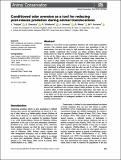Por favor, use este identificador para citar o enlazar a este item:
http://hdl.handle.net/10261/254293COMPARTIR / EXPORTAR:
 SHARE SHARE
 CORE
BASE CORE
BASE
|
|
| Visualizar otros formatos: MARC | Dublin Core | RDF | ORE | MODS | METS | DIDL | DATACITE | |

| Campo DC | Valor | Lengua/Idioma |
|---|---|---|
| dc.contributor.author | Tobajas, Jorge | - |
| dc.contributor.author | Descalzo, Esther | - |
| dc.contributor.author | Villafuerte, Rafael | - |
| dc.contributor.author | Jimenez, J | - |
| dc.contributor.author | Mateo, R. | - |
| dc.contributor.author | Ferreras, Pablo | - |
| dc.date.accessioned | 2021-11-11T12:50:29Z | - |
| dc.date.available | 2021-11-11T12:50:29Z | - |
| dc.date.issued | 2021 | - |
| dc.identifier | doi: 10.1111/acv.12643 | - |
| dc.identifier | issn: 1469-1795 | - |
| dc.identifier.citation | Animal Conservation 24: 373- 385 (2021) | - |
| dc.identifier.uri | http://hdl.handle.net/10261/254293 | - |
| dc.description.abstract | Predation is a key factor in prey population dynamics and could impact population recovery. One common means employed to recover prey populations is that of translocations, but most fail owing to high predation during the early stages. We tested whether conditioned odor aversion can reduce predation during animal translocations by using the predation of the European rabbit Oryctolagus cuniculus by the red fox Vulpes vulpes as a case study. Following a before-after control-impact design (BACI), we deployed bait stations monitored using camera-traps in two zones to which rabbits were translocated. One week before the rabbits were released, microencapsulated levamisole was added to rabbit baits located in the treatment zones, along with vanilla essence as an odor cue. A total of 148 rabbits were distributed in artificial warrens with the odor cue and 68 of them were fitted with radio collars in order to determine their survival rates. The response to the treatment and translocation as regards subsequent rabbit abundance was evaluated using N-mixture models, while rabbit establishment was evaluated using a warren use index (WUI). The treatment decreased the proportion of baits consumed by foxes, but this decrease was partially compensated by other predators. WUI and rabbit population growth increased significantly more after translocations in the treatment zones than in the control zones. The short-term survival of translocated rabbits was also higher in the treatment zones than in the control zones. Our study showed that conditioned odor aversion reduced rabbit predation by foxes, and had a positive effect on rabbit population growth after translocation, since there was an increase in rabbit survival and warren establishment. This method could be used as a non-lethal tool for the recovery of a key prey when carrying out programs concerning the reintroduction of endangered predators or for other vulnerable species requiring translocations. | - |
| dc.language | eng | - |
| dc.publisher | Cambridge University Press | - |
| dc.relation.isversionof | Publisher's version | - |
| dc.rights | openAccess | - |
| dc.subject | BACI | - |
| dc.subject | conditioned odor aversion | - |
| dc.subject | conditioned taste aversion | - |
| dc.subject | post-release survival | - |
| dc.subject | predation | - |
| dc.subject | predator–prey relationship | - |
| dc.subject | reintroductions | - |
| dc.subject | translocations | - |
| dc.title | Conditioned odor aversion as a tool for reducing post-release predation during animal translocations | - |
| dc.type | artículo | - |
| dc.identifier.doi | 10.1111/acv.12643 | - |
| dc.relation.publisherversion | http://dx.doi.org/10.1111/acv.12643 | - |
| dc.date.updated | 2021-11-11T12:50:29Z | - |
| dc.relation.csic | Sí | - |
| dc.type.coar | http://purl.org/coar/resource_type/c_6501 | es_ES |
| item.grantfulltext | open | - |
| item.openairetype | artículo | - |
| item.cerifentitytype | Publications | - |
| item.fulltext | With Fulltext | - |
| item.openairecristype | http://purl.org/coar/resource_type/c_18cf | - |
| Aparece en las colecciones: | (IESA) Artículos | |
Ficheros en este ítem:
| Fichero | Descripción | Tamaño | Formato | |
|---|---|---|---|---|
| Conditioned odor aversion as a tool for reducingpost-release predation during animal translocations.pdf | 575,31 kB | Adobe PDF |  Visualizar/Abrir |
CORE Recommender
SCOPUSTM
Citations
9
checked on 05-may-2024
WEB OF SCIENCETM
Citations
8
checked on 21-feb-2024
Page view(s)
40
checked on 15-may-2024
Download(s)
176
checked on 15-may-2024
Google ScholarTM
Check
Altmetric
Altmetric
NOTA: Los ítems de Digital.CSIC están protegidos por copyright, con todos los derechos reservados, a menos que se indique lo contrario.
